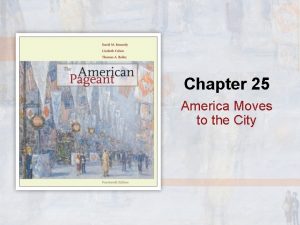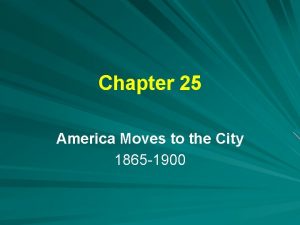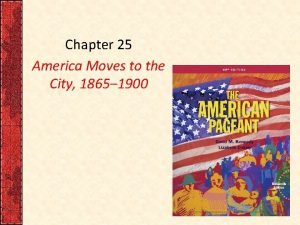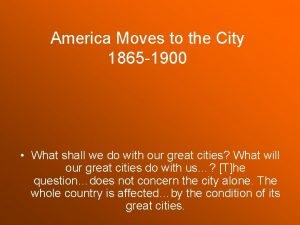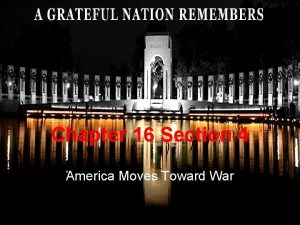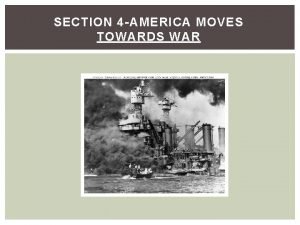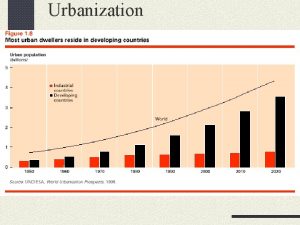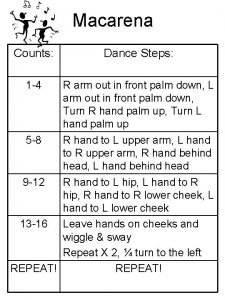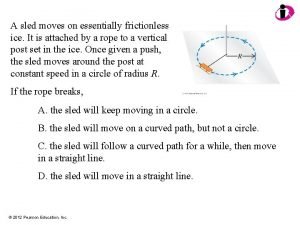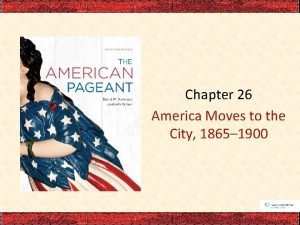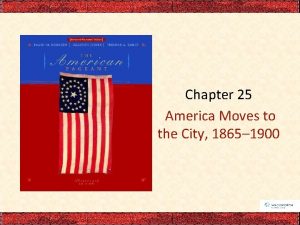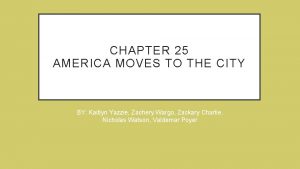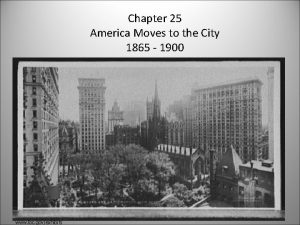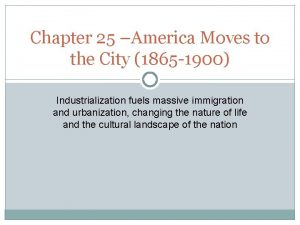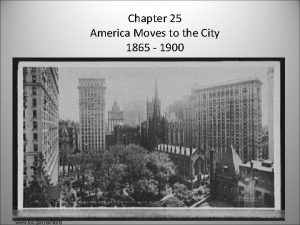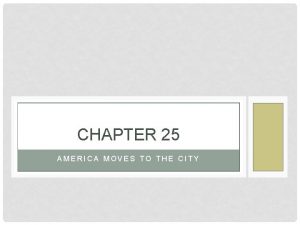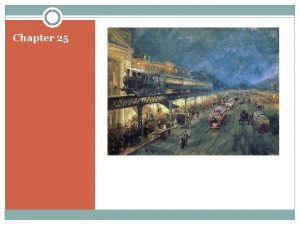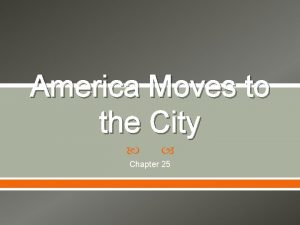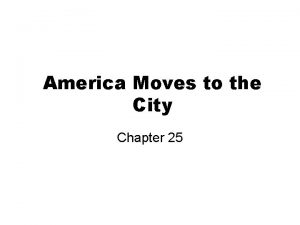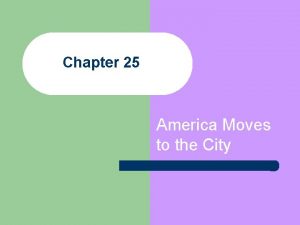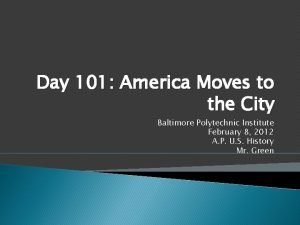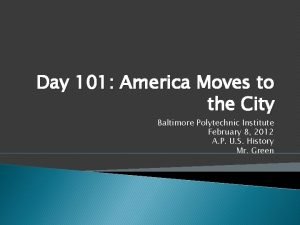Chapter 25 America Moves to the City America





















































































- Slides: 85

Chapter 25 America Moves to the City

America Moves to the City (18651900) By the year 1900, the U. S. population nearly doubled from what it was in 1870. � In the same period, the population of American cities tripled. This move to the city affected not only the U. S. but the entire industrializing world. � European peasants pushed off the land in part by competition from cheap American foodstuffs, were pulled into cities by the attractive industrial jobs.

The Urban Frontier In 1860 no city in the U. S. had a population of 1 million people. � By 1890, New York, Chicago, and Philadelphia had passed that mark. American cities grew up and out. � The skyscraper allowed more people and workplaces to be packed onto a parcel of land. The skyscraper was made usable by the electric elevator.

Size of World Cities Since 1850

The Urban Frontier American were also becoming commuters. � Electric trolleys, powered by wagging antennae from overhead wires, moved city limits outward. The compact, communal “walking city, ” its boundaries fixed by the limits of how far a person could walk, gave way to the megalopolis, carved into different districts for business, industry, and residential neighborhoods. � Each of these were segregated by race, ethnicity, and social class.

Lower Broadway, 1875 Horses still abounded in New York and other cities when this lithograph was made, but they would soon be displaced by street railways and automobiles.

The Urban Frontier Industrial jobs, more than anything, drew people off of the farms and abroad into the cities. � But the urban lifestyle also was attractive. Instead of predawn chores, you now have a the late night glitter of cities. Electricity, indoor plumbing, and telephones all made life in the big city more enticing. Cavernous department stores such as Macy’s in New York and Marshall Fields in Chicago attracted middle class shoppers and jobs, many for women.

The Urban Frontier The move to the city introduced Americans to new ways of living � Rural areas produced little household wastes. Domestic animals or scavenging pigs ate food scraps. Rural women repaired worn clothing rather than replace it. Household products were sold in bulk at a local store without wrapping. � In the city, however, goods came in throwaway bottles, boxes, bags, and cans. Apartment houses had nowhere to throw their scraps. Worn clothing was discarded and new clothing bought. � Waste disposal was an issue to the new urban age.

The Urban Frontier Issues surrounding the upward growing cities. Criminals flourished. � Sanitary facilities could not keep up with explosion in population. � Impure water, uncollected garbage, unwashed bodies, and droppings from animals provided the stench for the cities. � Worst of all were the human pigsties known as slums. � They seemed to grow ever more crowed, more filthy, and more rat-infested with the building of the “dumbbell tenements” in 1879. It was usually seven to eight stories, with shallow, sunless and ill-smelling air shafts providing minimal ventilation. Several families were squashed in on each floor and shared a toiled in the hall.

Dumbbell Tenement This was the standard architectural plan for the human warehouses on New York’s Lower East Side. Despite the innovation of an air shaft to bring light and ventilation to the middle of the building, only one room in each of the apartments was directly exposed to sunlight and open air. All families on a floor shared the toilet (“W. C. ”) in the hallway.

The Urban Frontier Cities were dangerous for everyone. � In 1871, Chicago burned. Closely packed wooden structures fed the flames, prompting Chicago and other cities to require stone and iron buildings downtown. The wealthiest began to leave the risky cities and move to semirural suburbs in what came to be known as “bedroom communities. ”

The New Immigration A seemingly endless stream of immigrants continued to pour in. � In each of the three decades from the 1850 s through the 1870 s, more than 2 million migrants had come over. � By the 1880 s more than 5 million. Until the 1880 s most immigrants had come from the British Isles and western Europe, chiefly Germany and Ireland, as well as 300, 000 Chinese. � Many of these faced nativism, especially the Irish and the Chinese.

The New Immigration By the last decades of the century, the “old” immigrants had adjusted well. � They built supportive ethic organizations and established farm communities or urban craft unions. They were now largely accepted as “American” by the native-born. In the 1880 s the character immigration changed. � The New Immigrants came from southern and eastern Europe. Italians, Jews, Croats, Slovaks, Greeks and poles.

The New Immigration The New Immigrants came from countries with little history of democratic government and where opportunities for advancement were few. � By the first decade of the twentieth century, they constituted 66 percent of immigration. � They lived together in cities like New York and Chicago, where “Little Italys” and “Little Polands” soon claimed more inhabitants than many of the largest cities of the same nationality in the Old World.

The New Immigration The New Immigrants were largely illiterate and impoverished. � They worshiped in Orthodox or Roman Catholic churches or synagogues. � Some birthed radical political ideas. These communities sheltered them from Americans who again had nativist fears that these New Immigrants would not, or could not, assimilate to life in their new land. � Skeptics, including “old” immigrants began asking whether the nation had become a melting pot or a dumping ground.

Mulberry Street on New York City’s Lower East Side, ca. 1900 Population densities in early-twentieth-century American cities were among the highest in the world. Mulberry Street, shown in this photo, was at the heart of New York’s “Little Italy” neighborhood.

Old and New Immigration (by decade) In the 1880 s the sources of immigration to the United States shifted from the British Isles and western Europe to southern and eastern Europe. A century later the old “mother continent” of Europe would account for only 10 percent of immigrants to America (see Figure 42. 4 on p. 1094).

Southern Europe Uprooted Why was there so much New Immigration? � In part, they left because Europe seemed to have no room for them. The population of the old world was growing. American food imports and European industrialization caused the peasantry to leave their customary occupations, creating rising unemployment. � “American Fever” proved highly contagious in Europe. Letters sent by friends and family painted America as a land of fabulous opportunity. � America was also blessed with freedom from military conscription and institutionalized religious persecution.

Southern Europe Uprooted Why was there so much New Immigration? � Profit-seeking Europe. Americans recruited throughout Industrialists wanted low-wage labor, railroads wanted buyers for their land grants, states wanted more population, and steamship lines wanted more human cargo for their ships. � Savage persecutions of minorities in Europe drove many to the American shores. In 1880 s, Russians turned violently upon their own Jews. These Jews experienced city life in Europe, making them unique among the New Immigrants. Many brought their urban skills to American cities.

Southern Europe Uprooted Many of the immigrants – birds of passage – never intended to become Americans. � These men, many of them single, returned home with their money. Even those who stayed struggled to preserve their traditional culture. � Catholics expanded their parochial-school system, Jews established Hebrew schools, foreign language newspapers, Greek restaurants, Italian social clubs. Yet the children of these immigrants grew up speaking fluent English, and often rejected the Old Country manners.

Pietro Learning to Write on Jersey Street “The sons shall teach the fathers, ” the old saying goes. Many immigrants learned English from their children who attended American schools, like this youngster and parent in early-twentieth-century New Jersey.

Italian Immigrant Women Doing Piecework at Home in New York, ca. 1910

Italian Construction Workers, ca. 1910

Jewish Women Working in a Sweatshop, ca. 1910 Countless immigrant women found their first American employment in shops like this.

Reactions to the New Immigration The federal government did virtually nothing to ease the assimilation of immigrants into American society. � State governments did even less. � City governments, overwhelmed by the sheer scale of rampant urban growth, proved inadequate. By default, the business of administering the immigrants needs fell to the unofficial “governments” of the urban political machines, led by “bosses” like New York’s Boss Tweed.

Reactions to the New Immigration “Unofficial governments” � They would trade jobs and services for votes, claiming the loyalty of thousands of immigrants. � In return for their support at the polls, the boss provided jobs on the city’s payroll, found housing for new arrivals, provided food, and patched up minor scrapes with the law, and helped get schools, parks and hospitals built in immigrant neighborhoods.

Reactions to the New Immigration The nations social conscience gradually awakened to the plight of the cities, especially the immigrants. � Preaching the “social gospel”, they insisted that churches tackle the social issues of the day. The Sermon on the Mount was the science of society, and many social gospelers predicted that socialism would be the logical outcome. Theses “Christian Socialists” did much to prepare the path for the progressive reform movement after the turn of the century.

Reactions to the New Immigration Jane Addams was deeply dedicated to uplifting the urban masses. � A first generation college-educated woman, she acquired the decaying Hull mansion in Chicago in 1889. � There she established the Hull House, the most prominent (not the first) American settlement house. Hull House was located in a poor immigrant neighborhood of Greeks, Italians, Russians and Germans. It offered instruction in English, counseling to help newcomers cope with big city life, child-care services and cultural activities for neighborhood residents. She condemned war, poverty and eventually won the Nobel Peace Prize in 1931. Following Addam’s lead, women founded settlement houses in other cities. � Among these was Lillian Wald’s Henry Street Settlement in new York, which opened its doors in 1893.

Hull House These immigrant children playing games at the settlement house that Jane Addams founded in Chicago were having some fun while also getting instruction from a settlement house worker in how to be a proper American.

Reactions to the New Immigration The settlement houses became centers of women’s activism and of social reform. � The women of Hull House successfully lobbied in 1893 for an Illinois anti-sweatshop law that protected women workers and prohibited child labor. The were led by Florence Kelley, who was a socialist and a battler for women, children, blacks, and consumers. She later moved to Henry Street Settlement in New York and served three decades as general secretary of the National Consumers league. The pioneering work of Addams, Wald, and Kelley help blaze the trail that many women later followed into careers in urban reform and the new profession of social work.

Reactions to the New Immigration More than a million women joined the work force in the decade of the 1890 s. � Employment for wives and mothers was considered taboo, so a majority were single. � Their jobs depended on race, ethnicity, and class. Black women had few opportunities beyond domestic service. White-collar jobs as social workers, secretaries, department store clerks and telephone operators were reserved for native-born. � Hours were long, pay low, and advancement was limited, a job still bought workingwomen some economic and social independence. Amusement parks and dances with the “fellas. ”

Narrowing the Welcome Mat Antiforeignism, or “nativism, ” that earlier began with the Irish and German arrivals in the 1840 s and 1850 s, was renewed. � Nativists viewed the eastern and southern Europeans as culturally and religiously inferior. They aroused alarm due to their high birthrate, which was common among people with a low standard of living, raised worries that the original Anglo-Saxon stock would soon be outbred and outvoted. � Native born Americans also blamed the immigrants for the degradation of urban government. Trade unionists didn’t like their willingness to work for low wages They were also condemned for their doctrines of socialism, communism, and anarchism.

Narrowing the Welcome Mat Antiforeign organizations, such as the American Protective Association (APA), were revived. � The APA was created in 1887 and pursued nativist goals by urging voting against Roman Catholic candidates for office and sponsored publications of lustful fantasies about runaway nuns. Organized labor joined in. � Frequently used as strikebreakers, the wagedepressing immigrants were hard to unionize because of the language barrier. � Labor unions argued that if American industry was entitled to protection from foreign goods, American workers were entitled to protection from foreign laborers.

Narrowing the Welcome Mat Congress finally acts. � In 1882, they passed the first restrictive law eliminating criminals and convicts from entering. � Also, 1882 brought forth a law to bar completely one ethnic group – the Chinese. � In later years, other federal laws lengthened the list to include the insane, polygamists, prostitutes, alcoholics, anarchists and people carrying contagious diseases. Other proposals included a literacy test, which would favor the old immigrants over the new.

Looking Backward Older immigrants, trying to keep their own humble arrival in America “in the shadows, ” sought to close the bridge that had carried them and their ancestors across the Atlantic.

Churches Challenge Confront the Urban Protestant churches suffered heavily from the shift to the city, where many of their traditional doctrines and pastoral approaches seemed irrelevant. Due to the wealth of their prosperous parishioners, many of the old-line churches were slow to raise their voice against social and economic vices. � John D. Rockefeller was a member of the Baptist Church. � J. P. Morgan was a member of the Episcopal Church. Materialism was emphasized; Money was the accepted measure of achievement, and the new gospel of wealth proclaimed that God caused the

Churches Challenge Confront the Urban Liberal Protestants � Rooted in the Unitarian revolt against orthodox Calvinism, liberal ideas came into the mainstream of American Protestantism. Liberal Protestants adapted religious ideas to modern culture, attempting to reconcile Christianity with new scientific and economic doctrines. They rejected biblical literalism, urging Christians to view biblical stories as models for Christian behavior rather than its dogma. They stressed the ethical teachings of the Bible and allied themselves with the “social gospel” movement and urban revivalists like Dwight Lyman Moody.

Morning Service at Moody’s Church, 1908 Thousands of Chicagoans found the gospel and a helping hand at evangelist Dwight Lyman Moody’s church. Although Moody himself died in 1899, his successors continued to attract throngs of worshipers to his church, which could hold up to ten thousand people.

Churches Challenge Confront the Urban Simultaneously, the Roman Catholic and Jewish faiths were gaining enormous strength from the New Immigration. By 1890 the variety-loving Americans could choose from 150 religious denominations. � 2 of them were brand new. The Salvation Army appealed to the down-and-outers, and did much practical good. The Church of Christ, Scientist (Christian Science) founded by Mary Baker Eddy in 1879 She preached that the true practice of Christianity heals sickness. The YMCA and YWCA grew enormously during this period.

Darwin Disrupts the Churches Modern trends questioned and affected the old -time religion through books on comparative religion and on historical criticism. � Most damaging were the writings of Charles Darwin set forth theory that higher forms of life had slowly evolved from lower forms, through a process of random biological mutation and adaptation. Nature in his view blindly selected organisms for survival or death based on random, inheritable variations that they happened to possess.

Darwin Disrupts the Churches By 1875, the majority of scientists in America and elsewhere had embraced theory of organic evolution, although not all endorsed natural selection. � Many supported an alternative proposed by French biologist Jean-Baptiste Lamarck who argued that traits acquired during the course of an individual’s life could shape the future genetic development of species.

Darwin Disrupts the Churches Clergymen and theologians responded to Darwin in a variety of ways. � At first, most believers rejected his ideas outright. � After 1875, the religious community split into two camps A conservative minority stood firmly behind the Scripture as the infallible Word of God and they condemned Darwin. Most religious thinkers flatly refused to accept the Bible in its entirety as either history or science. These “accomodationists” feared that hostility toward evolution would alienated educated believers. Eventually, liberal thinkers were able to reconcile Darwinism and Christianity: “some call it Evolution, And others call it God”

The Lust for Learning Public education continued to clime upward following the Civil War. � Americans were accepting that a free government cannot function successfully if the people are ignorant. � Beginning about 1870, more and more states began to make a least a grade school education compulsory. This helped check the abuses of child labor. Before the Civil War, private academies on the secondary level were common; public high schools were rare. � But the concept that a high school education, as well as a grade school education, was the birthright of every citizen was gaining support.

The Lust for Learning Teacher-training schools, then called “normal schools” expanded after the Civil War. Kindergartens, borrowed from Germany, gained more support. The New Immigration brought new strength to Catholic parochial schools.

The Lust for Learning Public schools excluded millions of adults. � This was partially remedied by the Chatauqua movement, launched in the 1874 in New York. Success was achieved through nation-wide public lectures, often held in tents and featuring well-known speakers, including Mark Twain. There were also extensive Chatauqua courses of home study which thousands of people enrolled in. Crowded cities generally provided better educational facilities than the old one-room, one-teacher schoolhouse. The success of the public schools is confirmed by the falling of the illiteracy rate from 20 percent in 1870 to 10. 7 percent in 1900.

The Lust for Learning The South lagged far behind other regions of the country in public education, with African Americans suffering the most. � 44 percent of non-whites were illiterate in 1900. The foremost champion of black education was an ex-slave, Booker T. Washington. � Washington taught black students useful trades so that they could gain self-respect and economic security. This was labeled “accommodationist” because it stopped short of challenging white supremacy.

Booker T. Washington (1856– 1915) In a famous speech in New Orleans in 1895, Washington grudgingly acquiesced in social separateness for blacks. On that occasion, he told his largely white audience, “In all things that are purely social, we can be as separate as the fingers, yet one as the hand in all things essential to mutual progress. ”

Education for Black People Washington avoided the issue of social equality. Why? � The depths of southern white racism. � He believed economic independence would ultimately be the ticket to black political and civil rights. Washington taught at the Tuskegee Institute, training young blacks in agriculture and the trades. Among the faculty was George Washington Carver, who became internationally famous and provided a much needed boost to the southern economy by discovering new uses for the peanut (shampoo, axle grease), sweet potato (vinegar) and soybean (paint).

Education for Black People W. E. B. Dubois called Washington an “uncle Tom” believing he was condemning their race to manual labor and perpetual inferiority. He was born in Massachusetts, earned a PHD at Harvard, the first of his race to do so. He demanded complete equality for blacks and helped found the NAACP in 1909 He argued that the “talented tenth” of the black community should be given full and immediate access to the mainstream of American life. This contrasts the difference in life experiences of southern and northern blacks.

The Hallowed Halls of Ivy Colleges and universities also grew after the Civil War. � Women and African American opportunities for higher education. were even finding Women’s colleges such as Vassar were gaining ground, and universities open to both genders were growing, notably in the Midwest. The phenomenal growth of higher education owed much to the Morrill Act of 1862. This law provided generous land grants to the states for public education. � Land grant colleges bound themselves to certain services, such as military training. � The Hatch Act of 1887 provided federal funds for the establishment of agricultural experiment stations. �

The Hallowed Halls of Ivy Private philanthropy richly supplemented government grants to higher education. � Noteworthy among the new private universities of high quality were Cornell (1865) and Leland Stanford Junior (1891). � The University of Chicago, opened in 1892, speedily forged into a front-rank position, owing largely to John D. Rockefeller died at ninety-seven after giving some $550 million for philanthropic purposes.

Stanford University Under Construction, Late Nineteenth Century

The Hallowed Halls of Ivy Significant also was the increase in professional and technical schools. � Most significant among these was Johns Hopkins University, opened in 1876, which maintained the nation’s first high-grade graduate school. Reputable scholars no longer had to go abroad for a respectable graduate degree. Woodrow Wilson, among other, received his Ph. D. from Johns Hopkins.

The March of the Mind Homegrown influences shaped the modern American university as much as German models. � Religious instruction in moral philosophy and natural theology served as pillars of the old classical curriculum. � In the wake of Darwinian challenge, when religion and science seemed less compatible, university reformers struggled to reconcile scientific education and religion to preserve the unity of moral and intellectual purpose. When the effort failed, university educators abandoned moral instruction and divorced facts from values.

The March of the Mind Other pressures also helped doom traditional curriculum. � New industrialization brought demands for “practical” courses and specialized vocational training in the sciences. � Reformers emphasized fields of concentration to prepare students for entry into a professions. � Specialization, not synthesis, became the primary goal of university education. When Dr. Charles Eliot became president of Harvard, he changed Harvard’s motto from Christo et Ecclesiae (For Christ and Church) to Veritas (Truth). This is a sign of secularizing times.

The March of the Mind Medical schools and medical science after the Civil War were prospering. � The new scientific times were reflected in improved public health. Discoveries abroad, such as French scientist Louis Pasteur and English physical Joseph Lister shaped the health recovery. As a result of new health-promoting precautions, including campaigns against public spitting, life expectancy at births was increased.

The March of the Mind One of America’s most brilliant intellectuals, William James, served for 35 years on the Harvard faculty. � His Principles of Psychology (1890) helped to establish the modern discipline of behavioral psychology. � In The Will to Believe (1897) and Varieties of Religion (1902), he explored the philosophy and psychology of religion. � In his most famous work, Pragmatism (1907) he introduced the idea of pragmatism – the truth of an idea was to be tested, above all, by its practical consequences.

William James (1842– 1910), Physician, Psychologist, and Philosopher

The Appeal of the Press Books continued to be a major source of edification and enjoyment. � Well stocked public libraries were making encouraging progress. The magnificent Library of Congress building (1897), provided thirteen acres of floor space in the largest and costliest of its kind in the world. � This new era was inaugurated by the generous gifts of Andrew Carnegie. He contributed $60 million for the construction of nearly 1700 public libraries all over the country and 750 around the world.

The Appeal of the Press Roaring newspaper presses more than kept pace with public demands. � But the investment in machinery and plant was accompanied by a fear of offending advertisers and subscribers. The “Penny The Chicago Daily Press” News was but one of several cheap, mass circulation newspapers that flourished in the new urban environment of Gilded Age America.

The Appeal of the Press Sensationalism was capturing the public taste. � The semiliterate immigrants created a profitable market for news that was simply and punchly written. Sex, scandal and other human-interest stories burst onto the headlines. Joseph Pulitzer was a leader in the technique of sensationalism. � His use of colored comics featuring “Yellow Kid” gave the name yellow journalism. A close competitor was William Randolph Hearst, who ultimately built a powerful chain of newspapers.

The Appeal of the Press Unfortunately, the overall influence of Pulitzer and Hearst was not all together good. � Both championed worthy caused, but also prostituted the press in their struggle for increased circulation. Both � Their “stooped, snooped and scooped to conquer. flair for scandal and sensational rumor was somewhat offset by the introduction of syndicated material and by the strengthening of the newsgathering Associated Press, which had been founded in the 1840 s.

Apostles of Reform Possibly the most influential journal of all was the liberal and highly intellectual New York Nation, which was read largely by professors, preachers and publicists. � Launched in 1865 by Edwin L. Godkin, it crusaded for civil-service reform, honesty in government and a moderate tariff. � The Nation had a modest circulation, but Godkin believed that if he could reach the right ten thousand leaders, his ideas through them might reach tens of millions.

Apostles of Reform Henry George was an original thinker who left an enduring mark. � After seeing poverty at its worst in India and landgrabbing at its greediest in California, took pen in hand. Progress and Poverty undertook to solve “the great enigma of our times” – “the association of progress with poverty. ” According to George, the pressure of a growing population on a fixed supply of land unjustifiably pushed up property values, showering unearned profits on owners of land. A single 100 percent tax on those windfall profits would eliminate unfair inequalities and stimulate economic growth.

Apostles of Reform Edward Bellamy published a socialistic novel, Looking Backward, in which the hero, falling into a hypnotic sleep, awakens in the year 2000. � He looks backward and finds that the social and economic injustices of 1887 have melted away under an idyllic government which has nationalized big business to serve the public interest. He heavily influenced American reform movements near the end of the century.

Postwar writing As literacy increased, so did book reading. � Post Civil-War Americans read millions of “dime novels, ” which often depicted the wilds of the wooly West. General Lewis Wallace sought to combat the prevailing wave of Darwinian skepticism with his novel Ben Hur: A Tale of the Christ (1880) Horatio Alger wrote more than a hundred volumes of juvenile fiction that sold over 100 million copies. � He wrote about a poor boy, through a combination of virtue, honesty, hard work, and bravery, could achieve success, wealth, and honor – a kind of survival of the purest, especially non-smokers, nondrinkers, nonswearers, and nonliars. He implanted in his readers moral lessons and the conviction that there is always room at the top.

Postwar writing In poetry, Walt Whitman was one of the few luminaries of yesteryear who remained active. � The assassination of Lincoln inspired him to write two of the most moving poems in American literature, “O Captain! My Captain!” and “When Lilacs Last in the Dooryard Bloom’d. ”

Literary Landmarks In novel writing the romantic sentimentality of a youthful era was giving way to a rugged realism that reflected more faithfully the materialism of an industrial society. � Kate Chopin wrote candidly about adultery, suicide, and women’s ambitions in the The Awakening (1899). Mark Twain had leapt to fame with The Celebrated Jumping Frog of Calaveras County (1867) and The Innocents Abroad (1869). He teamed up with Charles Dudley Warner in 1873 to write The Gilded Age, a satire on post-Civil War politicians and speculators, which gave the name to an era.

Literary Landmarks Twain typified a new breed of American authors in revolt against the elegant refinements of the old New England school of writing. Christened Samuel Langhorne Clemens, he had served for a time as a riverboat pilot. � After a brief stint in the armed forces, he journeyed westward to California, a trip he described, with a mixture of truth a tall tales, in Roughing It (1872). �

Literary Landmarks Twain wrote many other books. � The Adventures of Tom Sawyer (1876) preceded The Adventures of Huckleberry Finn (1884). His later years were soured by bankruptcy growing out of unwise investments, and he was forced to take to the lecture platform and amuse what he called the “damned human race. ” Journalist, humorist, satirist, and foe of social injustice, he made his most enduring contribution in capturing frontier realism and humor in the authentic American dialect.

Literary Landmarks Stephen Crane wrote about the steamy side of life in urban, industrial America. � His Maggie: A Girl of the Streets (1893), a brutal tale about a poor prostitute driven to suicide. � He rose to prominence with The Red Badge of Courage (1895), the story of a bloodied young Civil War recruit under fire. Henry James wrote The Bostonians (1886), one of the first novels about the rising feminist movement. � He frequently made women his central characters, exploring their inner reactions to complex situations.

Literary Landmarks Charles W. Chesnutt, a black writer, brought another kind of realism to latenineteenth century literature. � Chesnutt wrote fiction, primarily short stories embracing the use of black dialect and folklore, previously shunned by black authors, to capture the spontaneity and richness of southern black culture.

The New Morality Victoria Woodhull shook the pillars of conventional morality when she publicly proclaimed her belief in free love in 1871. � Together with her sister Tennessee Claflin, she published the periodical, Woodhull and Claflin’s Weekly. They also charged that Henry Ward Beecher, the most famous preacher of his day, had for years been carrying on an adulterous affair. Anthony Comstock, who made a lifelong war on the “immoral. ” � � Armed with the “Comstock Law” after 1873, Comstock boasted he had confiscated no fewer than 202, 679 “obscene pictures and photos”; 4, 185 “boxes of pills, powders, etc. , used by abortionists”’ and 26 “obscene pictures, framed on walls of saloons. ” He also proudly claimed that he had driven at least fifteen people to suicide.

The New Morality The antics of the Woodhull sisters and Comstock exposed to daylight the battle in late-nineteenth-century America over sexual attitudes and the place of women. � Switchboards and typewriters in the booming cities became increasingly the tools of women’s independence. � Young workingwomen headed to dance halls and nightclubs when the day was done, enjoying a new sense of freedom in the cities. This “new morality” began to be reflected in soaring divorce rates, the spreading practice of birth control, and increasingly frank discussion of sexual topics.

Victoria Woodhull (1838– 1927) Pleads for Woman Suffrage Before the House Judiciary Committee, 1871 A colorful and charismatic figure, Woodhull became the first woman to run for the presidency, in 1872, as the candidate of the Equal Rights party. Elizabeth Cady Stanton is seated directly behind her; at the extreme left sits Susan B. Anthony.

Families and Women in the City Many families cracked under the strain of the new urban environment. � The urban era launched the era of divorce. This would transform the United States’ social landscape in the twentieth century. Urban life also dictated change in work habits and family size. � Fathers, mothers and children as young as 10 often worked, usually in scattered locations. On the farm, having many children was useful to help with the farm. In the city they simply meant more mouths to feed, more crowding in the tenements and a hindrance to social mobility. Birthrates dropped and family size continued to shrink as the nineteenth century went on.

Families and Women in the City Women were growing more independent in the urban environment. In 1898, Charlotte Perkins Gilman published Women and Economics, a classic of feminist literature. � In this work, Gilman called on women to abandon their dependent status and contribute to the larger life of the community through productive involvement in the economy. � She advocated centralized nurseries and cooperative kitchens to facilitate women’s participation in the work force.

Families and Women in the City Feminists continued to insist on the ballot. � In 1890, they formed the National American Woman Suffrage Association (NAWSA). Its founders included aging pioneers Elizabeth Cady Stanton and Susan B. Anthony. By 1900, a new generation of women had taken command of the suffrage battle. Their most effective leader was Carrie Chapman Catt. � Under Catt, the suffragists de-emphasized the argument that women deserved the vote as a matter of right, because they were equal to men. � Instead, Catt stressed the desirability of giving women the vote if they were to continue to discharge their traditional duties as homemakers and mothers in the increasingly public world of the city.

Families and Women in the City By linking the ballot to a traditional definition of women’s role, suffragists registered encouraging gains as the new century opened. � Wyoming Territory granted the first unrestricted suffrage to women in 1869. Many states followed Wyoming’s example. The reborn suffrage women excluded black women, fearful inclusion would compromise its effort to get the vote.

Woman Suffrage Before the Nineteenth Amendment Dates show when a state or territory adopted woman suffrage. Note the concentration of woman-suffrage states in the West.

Prohibition Liquor consumption had increased during the Civil War, and immigrant groups, accustomed to alcohol in the Old Country, were hostile to restraints. The National Prohibition party, organized in 1869, polled a few votes in some of the ensuing presidential elections. � Feminist organized the Woman’s Christian Temperance Union (WCTU) in 1874. � Statewide prohibition, which had made surprising gains in Maine and elsewhere before the Civil War, was sweeping new states into the “dry” column. � The great triumph, temporarily, came in 1919, when the national prohibition amendment (Eighteenth) was attached to the Constitution.

Doused for the Cause, Minnesota, 1878 These umbrella-toting temperance crusaders stood their ground, despite the water poured on them by the indignant wife of the billiard-hall owner.

Artistic Triumphs Music was gaining popularity. � America of the 1880 s and 1890 s was assembling high -quality symphony orchestras, notably in Boston and Chicago. The newly rich enjoyed the imported singers, would flaunt their jewels, gowns and furs. While symphonies and operas were devoted to bringing European music to elite American audiences, new strains of homegrown American music were sprouting in the South. � Black folk traditions like spirituals were evolving into the blues, ragtime, and jazz, which would transform American popular music in the twentieth century.

The Business of Amusement The circus finally emerged with Phineas T. Barnum, the master showman joined with James A. Bailey in 1881 to stage the “Greatest Show on Earth. ” Baseball, already widely played before the Civil War, was clearly emerging as the national pastime. Basketball was invented in 1891 by Dr. James Naismith, designed as an active indoor sport that could be played during the winter months.

Cyclists on the Monterey Peninsula, California, 1888 Men and women alike took to the roads on the newfangled “two-wheelers. ” Bicycling especially appealed to young women eager to escape nineteenth-century strictures against female exercise and bodily exposure.
 America moves to the city chapter 25
America moves to the city chapter 25 Chapter 25 america moves to the city
Chapter 25 america moves to the city Chapter 25 america moves to the city
Chapter 25 america moves to the city America moves to the city
America moves to the city America moves to the city
America moves to the city Atlantic charter
Atlantic charter Chapter 24 section 4 america moves toward war
Chapter 24 section 4 america moves toward war America moves toward war section 4
America moves toward war section 4 Griffin ford model of the latin american city
Griffin ford model of the latin american city Cbd inner city outer city
Cbd inner city outer city Primate cities
Primate cities Latin american urban model
Latin american urban model Latin america urban model
Latin america urban model Latin america city model
Latin america city model Hát kết hợp bộ gõ cơ thể
Hát kết hợp bộ gõ cơ thể Lp html
Lp html Bổ thể
Bổ thể Tỉ lệ cơ thể trẻ em
Tỉ lệ cơ thể trẻ em Chó sói
Chó sói Chụp tư thế worms-breton
Chụp tư thế worms-breton Hát lên người ơi
Hát lên người ơi Môn thể thao bắt đầu bằng chữ f
Môn thể thao bắt đầu bằng chữ f Thế nào là hệ số cao nhất
Thế nào là hệ số cao nhất Các châu lục và đại dương trên thế giới
Các châu lục và đại dương trên thế giới Công của trọng lực
Công của trọng lực Trời xanh đây là của chúng ta thể thơ
Trời xanh đây là của chúng ta thể thơ Mật thư tọa độ 5x5
Mật thư tọa độ 5x5 Làm thế nào để 102-1=99
Làm thế nào để 102-1=99 Phản ứng thế ankan
Phản ứng thế ankan Các châu lục và đại dương trên thế giới
Các châu lục và đại dương trên thế giới Thể thơ truyền thống
Thể thơ truyền thống Quá trình desamine hóa có thể tạo ra
Quá trình desamine hóa có thể tạo ra Một số thể thơ truyền thống
Một số thể thơ truyền thống Cái miệng xinh xinh thế chỉ nói điều hay thôi
Cái miệng xinh xinh thế chỉ nói điều hay thôi Vẽ hình chiếu vuông góc của vật thể sau
Vẽ hình chiếu vuông góc của vật thể sau Thế nào là sự mỏi cơ
Thế nào là sự mỏi cơ đặc điểm cơ thể của người tối cổ
đặc điểm cơ thể của người tối cổ V cc
V cc Vẽ hình chiếu đứng bằng cạnh của vật thể
Vẽ hình chiếu đứng bằng cạnh của vật thể Phối cảnh
Phối cảnh Thẻ vin
Thẻ vin đại từ thay thế
đại từ thay thế điện thế nghỉ
điện thế nghỉ Tư thế ngồi viết
Tư thế ngồi viết Diễn thế sinh thái là
Diễn thế sinh thái là Dạng đột biến một nhiễm là
Dạng đột biến một nhiễm là Thế nào là số nguyên tố
Thế nào là số nguyên tố Tư thế ngồi viết
Tư thế ngồi viết Lời thề hippocrates
Lời thề hippocrates Thiếu nhi thế giới liên hoan
Thiếu nhi thế giới liên hoan ưu thế lai là gì
ưu thế lai là gì Hổ đẻ mỗi lứa mấy con
Hổ đẻ mỗi lứa mấy con Khi nào hổ con có thể sống độc lập
Khi nào hổ con có thể sống độc lập Hệ hô hấp
Hệ hô hấp Từ ngữ thể hiện lòng nhân hậu
Từ ngữ thể hiện lòng nhân hậu Thế nào là mạng điện lắp đặt kiểu nổi
Thế nào là mạng điện lắp đặt kiểu nổi Rap of the map of the us
Rap of the map of the us America 2 europe
America 2 europe Repetition in let america be america again
Repetition in let america be america again Why called latin america
Why called latin america Happening e performance
Happening e performance A bear searching for food wanders 35 meters east
A bear searching for food wanders 35 meters east A storm system moves 5000 km due east
A storm system moves 5000 km due east A storm system moves 5000 km due east
A storm system moves 5000 km due east T-mg=mv^2/r
T-mg=mv^2/r Heat always moves
Heat always moves Mlk timeline of events
Mlk timeline of events 4 functions of the stomach
4 functions of the stomach A transition analysis can account for multiple moves.
A transition analysis can account for multiple moves. Dylan williams feedback
Dylan williams feedback A football player runs directly down the field for 35 m
A football player runs directly down the field for 35 m In the position shown collar b moves to the left
In the position shown collar b moves to the left We live in planet earth
We live in planet earth Carbon moves from the atmosphere to plants
Carbon moves from the atmosphere to plants Macarena steps
Macarena steps Talk moves sentence starters
Talk moves sentence starters How does heat move
How does heat move Heat moves from
Heat moves from Earth's thickest layer
Earth's thickest layer Caravanpack.esm
Caravanpack.esm Author craft moves
Author craft moves Oceans
Oceans A skater moves with 15 m/s in a circle
A skater moves with 15 m/s in a circle Carbon moves from the atmosphere to plants
Carbon moves from the atmosphere to plants A sled moves on essentially frictionless ice
A sled moves on essentially frictionless ice It moves materials around to other parts of the cell
It moves materials around to other parts of the cell
